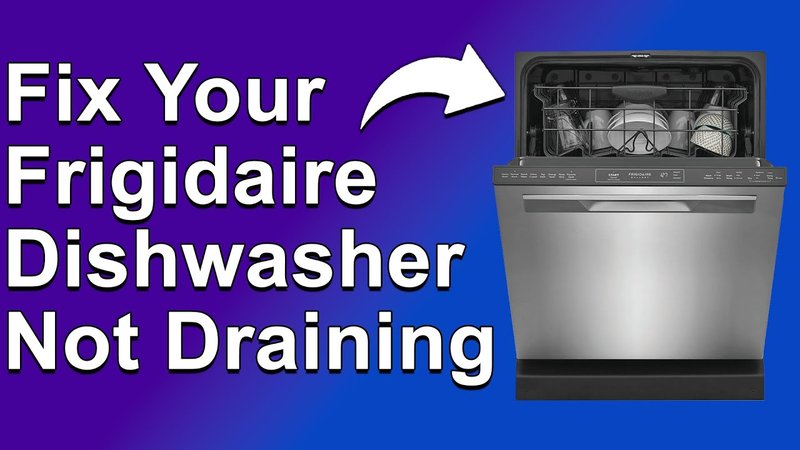
When your Frigidaire dishwasher flashes an Error F2, it indicates a water leak detection issue. Think of it as your dishwasher’s way of telling you, “Hey, there’s water where it shouldn’t be.” It’s like when your sink drips; you know you should fix it before it turns into a full-on leak. Ignoring this error might not only affect your dishwasher’s performance but can also lead to more severe damage, both to the appliance and possibly your kitchen floor. So, what really happens if you decide to turn a blind eye to this pesky error? Let’s dive in.
Understanding the Error F2 Code
The Error F2 code is like your dishwasher’s silent scream for help. It’s a warning that there’s a water leak somewhere inside your machine. Now, you might be wondering, “How does a dishwasher know it’s leaking?” It’s equipped with sensors that detect any unusual presence of water outside its regular path, somewhat similar to how a smoke detector senses smoke in the air.
When your appliance signals this error, it’s identifying a water leak, which can be caused by several factors. It might be due to a faulty water inlet valve, which works just like a tap controlling the amount of water entering your dishwasher. If this valve is failing, it can lead to overfilling or leaking. Another possible culprit could be a damaged gasket or seal, which is essential for keeping the water inside where it belongs. Just like a cracked glass won’t hold water, a compromised seal can’t keep your dishwasher’s insides dry.
Here’s the deal: ignoring these causes can worsen the problem. Over time, continuous leaking can escalate into water damage not just inside the dishwasher but also to your kitchen surfaces. The more water seeps into unwanted places, the more it risks damaging your floors, cabinets, and potentially creating mold, turning a minor inconvenience into a costly repair job.
Potential Consequences of Ignoring the Error
So, what happens if you let that F2 error slide? Let’s put it this way: ignoring it is like ignoring a growing crack in a dam. It might not seem like a big deal at first, but over time, the consequences can be significant. The most immediate effect is the efficiency of your dishwasher. It may not clean your dishes properly or may stop working altogether, leaving you to do the washing by hand.
But that’s just the start. Leaks, if left unchecked, could lead to substantial water damage in your kitchen. This isn’t just about having to mop up a little spillage. We’re talking about potential damage to your floorboards and cabinetry, which could rot away over time due to constant exposure to moisture. Imagine the headache of having to replace parts of your kitchen because of a tiny leak. It’s a hassle and an unexpected expense no one wants.
Moreover, there’s the health aspect. Standing water or damp areas can become breeding grounds for mold and mildew. Mold not only damages surfaces but can also pose health risks, especially for those with allergies or respiratory issues. It’s like letting a small wound fester—better to address it early than deal with infections later.
Solving the Error F2 Issue
Okay, so you’re convinced that leaving F2 errors unchecked isn’t the way to go. What can you do about it? First, it’s important to identify the source of the leak. This might involve checking the water inlet valve. If it’s like a leaky faucet, replacing it might stop the overflow.
Additionally, inspect the door seals and gaskets. These are the unsung heroes of your dishwasher, ensuring water stays inside. If they’re worn or cracked, it’s time for a replacement. Sometimes the solution is as simple as a little resealing.
You might not feel comfortable poking around in your dishwasher, and that’s perfectly okay. This is when calling in a professional can be your best move. They’re equipped with the knowledge to pinpoint the issue quickly and efficiently, saving you time and preventing further damage.
Preventative Measures for the Future
Once you’ve fixed the issue, the last thing you want is a repeat performance. Keeping your dishwasher—and kitchen—dry and damage-free is all about regular maintenance. Think of this like taking your car for regular check-ups to avoid breakdowns. Regularly inspect the door seal and gaskets for wear and tear. These components should be replaced as soon as they show signs of damage.
It’s also wise to routinely check for any signs of leaks, such as pooling water under your dishwasher. Addressing small leaks early can prevent bigger problems down the line. Like tending to a garden, a little attention goes a long way.
Finally, make sure to use your dishwasher correctly. Overloading it can lead to poor performance and put unnecessary strain on its parts. Follow the manufacturer’s guidelines for loading and detergent use. Remember, the better care you take of your dishwasher, the better care it will take of your dishes.
In conclusion, ignoring an Error F2 on your Frigidaire dishwasher is like ignoring a lit check engine light in your car. It’s not going away and will likely lead to bigger headaches down the road. Address the issue promptly, and with regular maintenance, you can keep your trusty dishwasher running smoothly for years to come.